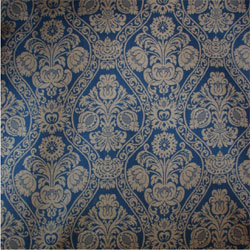 |
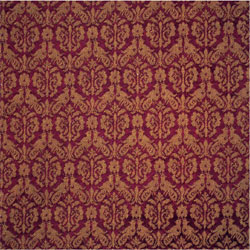 |
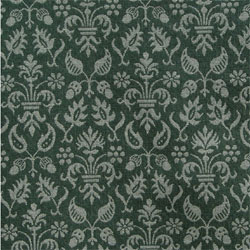 |
| Abbeville
This design, circa 1650, was thought originally to have been produced
in the French, medieval town of Abbeville, situated near the Somme,
northwest of Amiens. We closely replicate the double cloth construction.
Composition: 100% wool or wool/linen
Width 145cm ~ pattern repeat 45cm
|
Ariele
Originally an Italian 16th century silk damask, a very typical,
small pattern design with examples of this and similar in all major
European museum collections.
Composition: Mercerised cotton/worsted or silk/worsted
Width 125cm ~ pattern repeat 10cm |
Arno
A 17th century design taken from the many typical, Italian woven
examples found in the Museum collections of the Victoria & Albert,
Bargelo and Cleveland, USA.
Composition: mercerised cotton/wool
Width 125cm ~ pattern repeat 16cm |
Price: 1490 SEK/metre
|
Price: 1230 SEK/metre
|
Price: 1230 SEK/metre
|
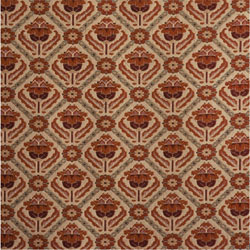 |
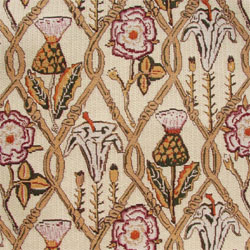 |
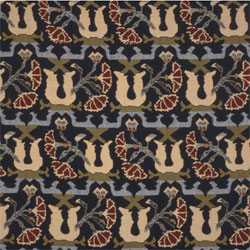 |
| Chastleton
This design is adapted from a 16th century needlework pattern on
a chair cover, part of the Chastleton House collection. Woven as
a reversible double cloth
Composition: 45% wool, 65% mercerised cotton
Width 125cm ~ pattern repeat 15cm |
Darnley
Inspired by a 16th century needlework panel attributed to Mary Queen
of Scots, part of the Hardwick Hall collection.
The interlaced trellis frames roses, thistles and lilies alluding
to Mary’s double crown of France and Scotland and her claim
to the throne of England. Woven in the muted shades of the original
as we see it now – ivory, fern green, gold and rose
Composition: 40% wool, 60% mercerised cotton,
(55% mc / 5% silk optional)
Width 125cm ~ pattern repeat 27cm |
Dianthus
This design derives from the earliest dated English pile carpet.
The beautiful running floral pattern of the original carpet, evocative
of the Elizabethan period, surrounds a central motif bearing the
arms of Queen Elizabeth and the date 1570. Woven as a woollen double
cloth.
Composition: 100% wool
Width 152cm ~ pattern repeat 43cm |
Price: 1680 SEK/metre
|
Price: 1680 SEK/metre |
Price: 1680 SEK/metre |
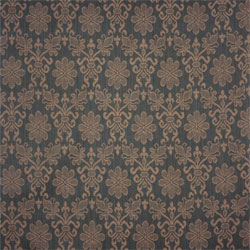 |
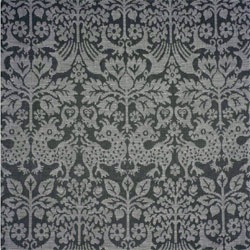 |
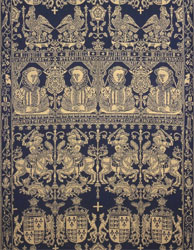 |
| Dornix
Derived from English designs from the 17th century, originally
woven for use as wall hangings and domestic furnishings.
Composition: 100% wool
Width 145cm ~ pattern repeat 30cm |
Dragon and owls
The linen and silk original of this 17th century German design can
be seen in the cathedral of Lund
Composition: 100% wool or wool/linen
Width 145cm ~ pattern repeat 50cm |
Elizabethan Wall Hanging
This design is taken from a linen serviette woven in Harlem dating
from the end of the 16th century. Replicated as a double cloth.
Composition: 100% wool or wool/linen.
Width 190cm ~ pattern repeat 110cm |
Price: 1490 SEK/metre
|
Price: 1490 SEK/metre |
Price: 1760 SEK/metre |
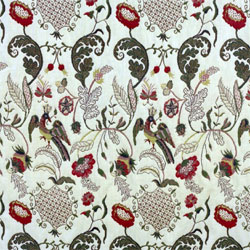 |
 |
 |
| English needlework
This floral design is typical of the needlework pieces worked at
the beginning of the 18th century in England. The design is taken
from a needlework panel at Cotehele Manor, with the phoenix representative
of the fashion of the period for Eastern culture and decoration.
Composition: Wool/cotton
Width 124cm ~ pattern repeat 57cm |
Fiore
Likely to have been woven in the second half
of the 17th century, with reference taken from a catalogue of Italian
silks from the Museo Nazionale in Lucca. Originally woven as a brocatelle
in silk and linen, the design comprises of a structure of branches
hidden by flowers and fringed foliage, surmounted by a carnation.
Composition: Wool/linen
Width 172cm ~ pattern repeat 59cm |
Fleur de lys
This design is taken from a photograph of a bed coverlet on a 15th
century French, tester bed. Woven with wool and bourette silk wefts
on a striated woollen warp to produce a fully reversible cloth.
Composition: Wool/natural silk
Width 145cm ~ pattern repeat 25cm |
Price: 1790 SEK/metre
|
Price: 1680 SEK/metre |
Price: 1680 SEK/metre |

|
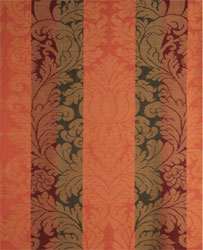 |
 |
| Genoa Damask
Design deriving from a 17th century Italian silk damask
from the Museum collection of Genoa. Almost identical documents
may be found in other European collections including the V&A
Museum and Hampton Court Palace. Woven as a fully reversible, true
damask
Composition: 100% wool
Width 125cm ~ pattern repeat 88cm |
Genoa Striped Damask
Design deriving from a 17th century
Italian silk damask from the Museum collection of Genoa. Almost
identical documents may be found in other European collections including
the V&A Museum and Hampton Court Palace. This striped version
represents one way in which designs were adapted in the 17th century.
Shown here woven in historically documented colours.
100% wool
Width 124cm ~ pattern repeat 88cm |
Heraldic beasts
Originally a 14th century Lucesse silk design,
it is typically medieval, although popularised and woven again through
the Gothic Revival period. The design adapted and woven in the form
of a double cloth.
Composition: 100% wool or wool/linen
Width 172cm ~ pattern repeat 85cm |
Price: 1490 SEK/metre
|
Price: 1490 SEK/metre |
Price: 1680 SEK/metre |
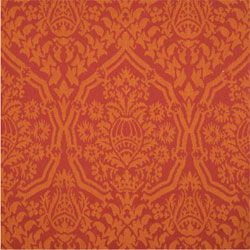 |
 |
 |
| Medici
This is a typical 15th century Gothic
design, woven extensively in Italy for over the a century. Woven
construction of a 3:1 crows’ foot twill.
Composition: 100% wool or wool/linen
Width 145cm ~ pattern repeat 47cm
|
Medieval Swans
This type of design was woven in Italy, near Florence, from the
14th century and is still woven in Sardinia. The V&A Museum
refer to the original as a Perugian towel or tablecloth cover. Woven
with the same lampas type of weave construction.
Composition: 100% wool
Width 145cm ~ pattern repeat 16cm |
Pomegranate
A copy of a French 16th century, Arras tapestry
design typical of those coarsely woven for use as wall-hangings
and once commonly furnishing middle-class houses of the period.
Composition: 100% wool or 64% wool/36% linen
Width 145cm ~ pattern repeat 40cm |
Price: 1490 SEK/metre
|
Price: 1680 SEK/metre |
Price: 1680 SEK/metre |
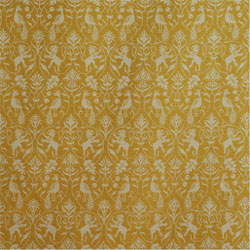 |
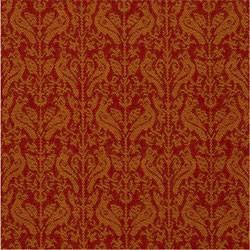 |
 |
| Rampant Lions
An example of a Florentine design woven extensively throughout the
17th century. Original examples can be found in the museum collections
of the V&A, Bargelo and Cleveland, USA.
Composition: Wool/Mercerised Cotton
Width 125cm ~ pattern repeat 20cm |
Small Falcons
An adaptation of a 13th century Sicilian silk design
Composition: 100% wool
Width 145cm ~ pattern repeat 9cm |
Tree of Life
This replicates the design and original colours of a set of English
made crewelwork bed hangings, dated from the late 17th / early 18th
century, from the V&A Museum archives, London.
Composition: Wool & combed cotton
Width 125cm ~ pattern repeat 90cm |
Price: 1280 SEK/metre
|
Price: 1490 SEK/metre |
Price: 1680 SEK/metre |
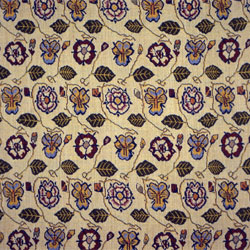 |
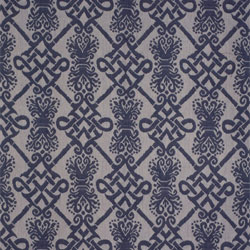 |
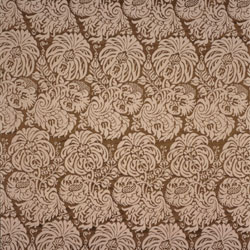 |
| Rose and Pansy
This design is taken from an English ‘turkeywork’ chair
covering, Circa 1610-1620
Composition: 100% wool
width 145cm ~ pattern repeat 29cm
|
Knot garden
A 16th century Italian silk damask design of interlocking geometric
form, referenced from the V&A Museum archive collection.
Composition: Silk & wool
Width 125cm ~ pattern repeat 24cm |
Lucca
A mid 17th century design, the reference taken from a catalogue
of Italian silks from the Museo Nazionale, Lucca. The pattern type
known as a ‘three flower damask’, is one very typical
of the period, comprising of two repeating chrysanthemum flower
motifs, alternating in direction.
Composition: 100% silk
Width 124cm ~ pattern repeat 51cm |
Price: 1680 SEK/metre
|
Price:
|
Price: 1840 SEK/metre
|
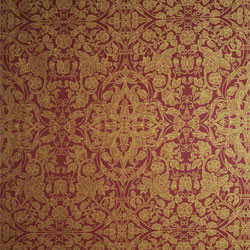 |
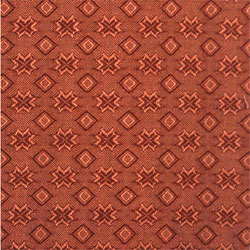 |
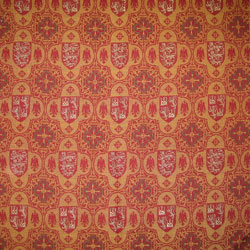 |
| Walsingham
This design was taken from an ivory white panel of silk damask,
over-worked with embroidery of typical English style, circa 1554.
It shows the controlling lines of an Eastern Arabesque influence,
suggestive of England’s growing interest in the affairs of
a widening world.
Reference taken from the V&A Museum in London
Composition: 100% wool
Width 145cm ~ pattern repeat 77cm |
Worcester tyg
This design is an adaptation of the small diaper designs
typical of 16th century worsted textiles produced by weavers in
the midlands and western counties of England.
Composition: 100% wool
Width 145cm ~ pattern repeat 3cm |
Heraldic Quarterfoil
A historical pattern for recreating Edward I bed chamber in Tower
of London, 13th century.
Composition: Wool, silk & Metallic Threads or
Wool or Wool/mercerised cotton.
Width 145 cm ~ pattern repeat
25 cm |
Price: 1680 SEk/metre
|
Price: 1490 SEK/metre
|
Price: 1680 SEK/metre (100% wool
or Wool/Mercerised Cotton), 1760 SEK/metre (Silk/Linen)
|
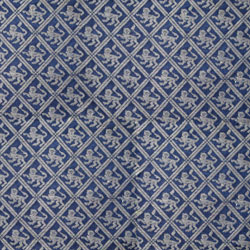 |
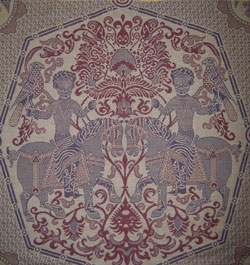 |
|
| Lion Diaper
A historical pattern for recreating Edward I bed chamber
in Tower of London, 13th century.
Composition: Silk & linen
Width 125 cm ~ pattern repeat
7 cm |
The Falconer
A Persian pattern, 11th century.
Composition: Wool/linen
Width 172 cm ~ pattern repeat 110 cm |
|
Price: 1490 SEK/metre (wool, linen
or mercerised cotton), 1760 SEK/metre (silk/linen)
|
Price: 1760 SEK/metre
|
|
